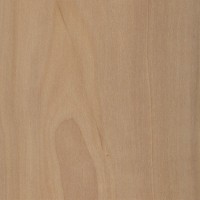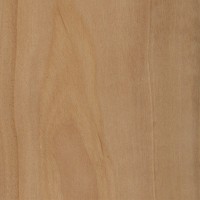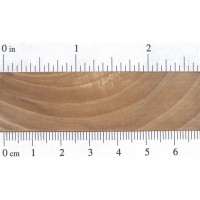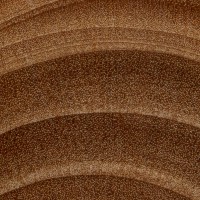 |
Common Name(s): Apple, Crab Apple, Wild Apple Scientific Name: Malus spp. (Malus domestica, Malus sieversii, Malus sylvestris, etc.) Distribution: Found throughout most temperate climates Tree Size: 13-30 ft (4-9 m) tall, 1 ft (.3 m) trunk diameter Average Dried Weight: 52 lbs/ft3 (830 kg/m3) Specific Gravity (Basic, 12% MC): .61, .83 Janka Hardness: 1,730 lbf (7,700 N) Modulus of Rupture: 12,800 lbf/in2 (88.3 MPa) Elastic Modulus: 1,270,000 lbf/in2 (8.76 GPa) Crushing Strength: 6,030 lbf/in2 (41.6 MPa) Shrinkage: Radial: 5.6%, Tangential: 10.1%, Volumetric: 17.6%, T/R Ratio: 1.8 |
Color/Appearance: Heartwood can vary from a light reddish or grayish brown to a deeper red/brown. The grain of Apple is sometimes seen with streaks of darker and lighter bands of color, similar to Olive. Sapwood is a pale cream color.
Grain/Texture: Grain is straight (though on some sections of the tree it can also be wild). With a very fine, uniform texture, closely resembling Cherry.
Endgrain: Diffuse-porous; small to very-small pores tending to occur in increased frequency in earlywood zone; exclusively solitary; growth rings distinct; rays usually not visible without lens; parenchyma not typically visible with lens.
Rot Resistance: Apple is rated as non-durable for heartwood decay.
Workability: Apple can be somewhat difficult to work due to its high density, and can burn easily when being machined. Apple glues, stains, finishes, and turns well.
Odor: Apple has a faint, sweet scent while being worked.
Allergies/Toxicity: Besides the standard health risks associated with any type of wood dust, no further health reactions have been associated with Apple. See the articles Wood Allergies and Toxicity and Wood Dust Safety for more information.
Pricing/Availability: Apple is seldom available in lumber form, and is usually seen only in very small sizes when available. Likely to be rather expensive, and is usually meant for only small projects and specialized applications.
Sustainability: This wood species is not listed in the CITES Appendices or on the IUCN Red List of Threatened Species.
Common Uses: Fine furniture, tool handles, carving, mallet heads, turned items, and other small specialty wood objects.
Comments: Apple has a high shrinkage rate, and experiences a large amount of seasonal movement in service. Its appearance and texture closely resemble Cherry, another fruit tree. Yet Apple is significantly heavier and harder than Cherry, and is excellent for turning.
None available.
Scans/Pictures: A special thanks to Steve Earis for providing the wood sample (endgrain zoom) of this wood species.





A bowl in crab apple
Would apple be a possible substitute for boxwood with it’s relatively high density, hardness and pale colour?
yea, it works well for boxing on hand planes. I know starvos gakos on youtube uses apple quite often for boxing on his hand planes.
Many, many years ago I had a wonderful woodworking teacher at high school. He always said that cooking utensils (e.g. spoons) should always be made of a fruitwood (generally lower toxicity than most other woods) preferably apple or pear. Of course this was in England where those two woods are probably the most common fruitwoods available. (With plums a close third.)
Having turned dozens of bowls from seasoned apple, few obsv: internal stress cracks are common, and often not seen until turning proceeds; expect substantial tangential shrinkage post-turning in dried wood; spectacular spalting is common in cut pieces stored on damp ground (typical patterns of spalting are small yellow dots well distributed – see pic). Wonder if stress cracks are because boles have repeated high loads from ripe apples each summer, followed by loss of loads after fruit falls or is picked?
This wood from apple trees looks great for gun stocks.. is it ?
No apple is not a very stable wood. for a gunstock you need stable wood like mahogony walnut or rosewood
Just got a couple of small pieces from a co-worker; can’t wait to work with it.
I had an apple tree in my front yard. Some branches had been going dead so I did some pruning and kept some of the wood. I made some pipe bowls with it. It is pretty dense but it carves nicely. feels a little like a soft soapstone
Have turned few dozen small boxes with lids from seasoned apple limbs. In sizes about 3 inch diam and 7 inch long, with finished thickness less than 3/8 inch, appears stable with no finish inside and 2 coats oil finish outside. Attractive grain of wood with secure bark.
how were the limbs seasoned? Did they crack?
I have a old cabinet that was in my first house. The old couple we boyght the house from said it was apple wood. We took it with us 34 years ago and at that time the house was 100 years old. The rathboards and plaster seemed as though it was built around the cabinet. Where can I go to find out more information. Thank you for your time and a very happy new year.
Took down a common apple tree in the back yard and let it season. Amazing colors out of the trunk and has a stout feel even in thinner cuts. I will be making some boxes with the better looking cuts, tool handles with straight grain and cutting boards with the bulk of it…seems to be a great wood overall if you have access to it
The body of the text describes it as cherry
Cherry is described as rot resistant and stable, but softer… apple as non-durable to decay and high rate of seasonable movement, yet harder.
Cherry sounds much more useful